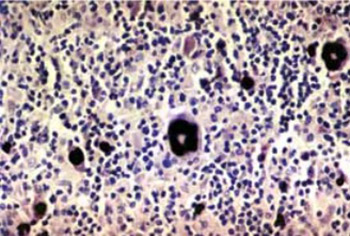Association of Hodgkin's lymphoma with Epstein Barr virus infection
DOI:
https://doi.org/10.17305/bjbms.2007.3092Keywords:
Hodgkin’s lymphoma, immunohistochemistry, Epstein-Barr virus, LMP-1, EBER RNK, in situ hybridizationAbstract
The role of Epstein Barr virus (EBV) in the onset of Hodgkin's lymphoma has been a subject of ongoing research. However, confirmation of EBV oncogenic involvement was not possible due to the small number of neoplastic cells characteristic for this type of tumor. Presence of EBV infection in neoplastic and non-neoplastic cells was analyzed in 81 cases of Hodgkin's lymphoma. In neoplastic cells, using an immunohistochemical method, latent membrane protein 1 (LMP1) was found in 33,3% of cases, while in situ hybridization results demonstrated the presence of EBER RNA in 48,1% of the cases. EBER RNA was found in non-neoplastic lymphocytes in 38,3% of cases. EBV is most frequently associated with Hodgkin's lymphoma in the first and seventh decade of life, specifically the nodular sclerosis subtype. No apparent difference was observed in the association of Hodgkin's lymphoma with EBV between genders, or in relation to clinical stage of the disease and average age of the patient. However, association with childhood age is significantly greater in comparison to adults. EBV associated disease shows a significantly greater prevalence in T lymphocytes. Slightly more abundant are cytotoxic T lymphocytes, which are also more frequently in contact with Reed-Sternberg cells, although there is no difference in number and positioning of histiocytes. Variations between the data on the association of EBV with Hodgkin's lymphoma among studies from different parts of the world suggest that factors of age, gender, ethnic background and social status might present biological modifiers of EBV influence on the pathogenesis of this neoplasm. The differences in non-neoplastic infiltrate EBV+ and EBV- lymphoma indicate the effect of the virus on the immune interaction of tumor and host in this disease.
Citations
Downloads

Downloads
Published
How to Cite
Accepted 2018-01-28
Published 2007-02-20









